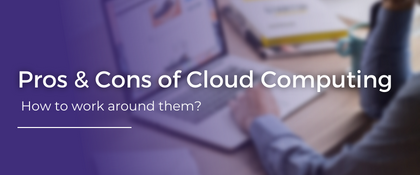Cloud Computing The Global Standard Of Internet Business
Summary
Cloud computing has revolutionized the way we use technology, enabling seamless data processing across interconnected devices. It encompasses different deployment models such as public, private, and hybrid clouds, and service models like IaaS, PaaS, and SaaS. Cloud computing offers benefits like scalability, security, cost-effectiveness, anywhere access, and business continuity. Top languages for cloud computing professionals include SQL, R, Python, Perl, and Ruby. A Big Data certification with machine learning basics can be beneficial in this field, as big data and machine learning contribute to the rise of cloud computing.
Table of Content
Today's devices are all inter-connected due to innovations in the field of digital technology. There are many devices around us designed to make our work easier. The internet has become omnipresent for our day to day activities.
Let us see two scenarios where internet services comes into play....
Scenario 1: You need to go to attend a musical convention. You want to book a cab, so what do you do?
You open a taxi app on your smartphone which is connected to the internet. You enter your destination and choose your mode of payment. That's it, you're done. How easy is that !
Scenario 2: You want to order your favorite pizza. How do you place your order?
You open a food delivery app on your tablet which is connected to the internet. You choose your favorite pizza, mode of payment and time of delivery. That's it, you receive your pizza at the chosen time.
This is an integrated and seamless way of processing data. It is possible due to a technology widely known as "Cloud Computing". The fields of big data and machine learning have contributed to the rise of cloud computing (Also check out the cloud computing certification that guides you through the course). A Big Data certification with machine learning basics can help you have a rising career graph.
Today computing can be performed in distributed environments with wireless devices. It is important to know the difference between cloud computing and cloud. We have explained it here:
"Cloud Computing": It can be defined as the use of computing resources as a service.
"Cloud": A third party provider or company hosts the physical or virtual computing resources. It includes all the necessary hardware and software. These resources are then distributed on a network collectively known as the "Cloud".
Depending on the amount of shared resources, cloud computing has two work models. They are:
1. Cloud Computing Deployment Models
2. Cloud Computing Service Models
Types of Cloud Deployment Models
Public Cloud: A cloud provider hosts the services and infrastructure over a network(the internet). Various users can access this service as it is available on a public network.
The security level for this model is low due to multiple user access. It is a scalable model and also has different costs for maintenance. An example for a public cloud is Amazon Web Services.
Private Cloud: A cloud provider hosts the services/infrastructure on a private network. Depending on the needs, a single client (corporate entities) can access the private cloud.
The security level of a private cloud is greater than a public cloud. This is because a private cloud is for exclusive access. The owner of the private cloud can exercise control over the use of resources. An example for a private cloud is the internal servers located in a corporate house.
Hybrid Cloud: The elements of a private and public cloud form the hybrid cloud. There can be multiple cloud servers which can be public and private. Computing is done on external or internal servers.
The workload can be shared on a hybrid cloud as per the need and demand. Computing resources that are non-critical can be shared on the public cloud. Sensitive and critical computing can be shared on the private cloud.
In this way, the hybrid cloud manages the processing of data in a business setup. It is flexible, scalable and has one of the best security. It is the ideal option for businesses that focus on demand and security.
Types of Cloud Service Models
-
Infrastructure as a Service(IaaS)
This model deals with the infrastructure required to host a cloud. They can be physical servers or virtual servers. A provider offers APIs, storage space and network required to launch an IT platform.
A client can choose the infrastructure as per their need. The service is cost effective as it is subscription-based. You pay only for the services needed which offers great benefits. Small,medium and large business use the IaaS model.
-
Platform as a Service(PaaS)
The cloud providers offer a software stack with the infrastructure in this model. Any development related work can be done with the help of the software hosted on the provider systems.
A client can create web applications as per the business needs. They can select features that appeal to their business. It is ideal for companies with a global presence as they have developers everywhere.
An example for a PaaS is an e-commerce website payment system. This can be hosted on a remote server of a banking merchant for handling sensitive data.
3. Software as a Service(SaaS)
This is the most common form of computing available. The model involves delivery of software over a network(the internet). The application is hosted by a cloud provider and clients gain access through the net.
All web based software fall under this category. Examples of SaaS services are web based e-mail, Office 365, social networking sites.
Benefits of Cloud Computing
-
Scalability:
An enterprise can scale up its operations when there is more demand and scale down when the demand is less.
-
Security:
Cloud computing offers high security levels for stored data. If a physical server goes down for some reason, the data is not lost. It is safely stored in the cloud and can be accessed from anywhere.
-
Control:
There is greater control of data stored in the cloud. Sensitive data can be accessed only by a few people. Since the data is shared on the net, there is transparency and one can analyze what kind of data is being accessed.
-
Cost Effectiveness:
The different models of cloud computing enable choosing the best platform for cloud services (here's some resource to help you navigate through cloud service providers). This means you can have the best computing resources for your business. The options vary from a subscription-based model to buying the hardware. There are many cost benefits to set up your business in the cloud.
-
Anywhere Access:
Cloud computing is platform neutral. This means you can access the internet on a variety of devices. You can access the cloud services on a smartphone, laptop, tablet or desktop.
-
Business Continuity:
One of the benefits of having the data stored in the cloud is it ensures the business continuity. The workflow for a business process can get affected due to unforeseen situations. If the systems for a service is down at one location, then a back up through cloud computing can take over. This way the business workflow continues with minimal loss.
-
Software Updates:
The maintenance of a cloud service is far easier compared to a physical server system. Cloud service providers make software updates to improve the efficiency of the service. Security upgrades in the cloud are done from time to time to protect sensitive and critical data.
Top Languages for Cloud Computing
The demand for cloud professionals is growing day by day. You must have any of the following skills to make a career in cloud computing. The languages in high demand are:
-
SQL: Structured Query Language
-
R Programming
-
Python Programming
-
Perl Programming
-
Ruby Programming





